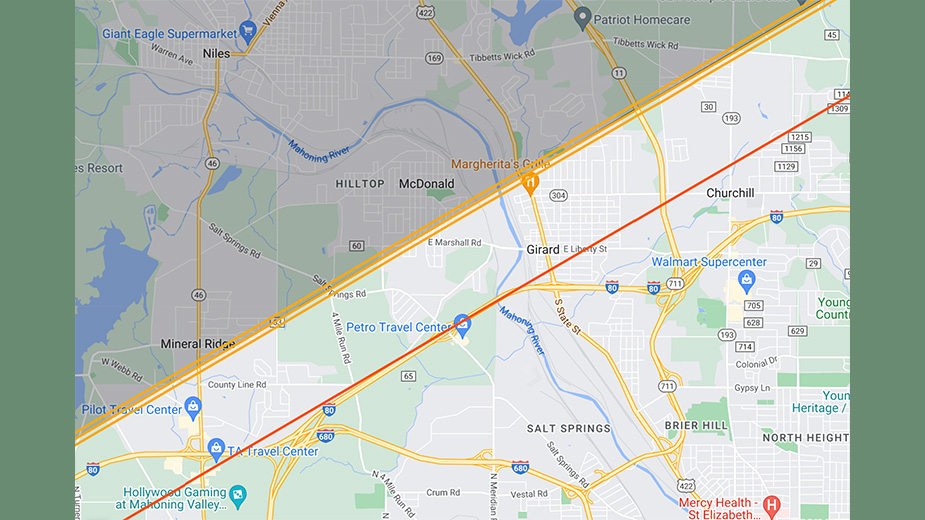Eclipse Draws the Line Directly Over the Valley
YOUNGSTOWN, Ohio – The solar eclipse that will pass over northeastern Ohio on April 8 will bring less than four minutes of totality.
But it’s a once-in-a-lifetime event.
Hotels and rental apartments have long been booked solid from Niles to Ashtabula, and watch gatherings are planned at several places in Trumbull County, which is almost entirely in the zone of totality.
Schools throughout the region will dismiss early or have the day off, and it’s doubtful that much work will get done in business offices that afternoon.
The eclipse can be seen anywhere in the region, be it total or partial, provided the weather cooperates. Forecasts are calling for partial cloudiness but no rain and a high in the low 60s.
There is no need to go anywhere to view it, but watch events will take place at Eastwood Mall in Niles, Skyway Drive-in in Warren, the Foxconn plant in Lordstown, Mosquito Lake State Park in Cortland, Shenango Lake in Pennsylvania, The Grand Resort in Howland, Mollenkopf Stadium in Warren and several other places. For a list, click HERE.
The eclipse will be seen in totality – the moon completely blocking the sun – within a swath ranging from 108 to 122 miles in width that will pass through Ohio between 3:08 and 3:19 p.m., moving in a northeasterly direction.
The Mahoning Valley lies partially within that swath, with the edge line running halfway between Youngstown and Warren, and directly over northern Girard.
Earlier this week, a solar physicist released findings that claim the swath of totality will be about 2,000 feet narrower than NASA’s projections. The report is based on new and supposedly more accurate calculations that prove the sun is slightly bigger than earlier measurements suggest.
As a result, the report moves the cutoff line of the southern edge of the swath about 10 city blocks to the north.
That means, to see a total eclipse in Girard, a viewer would have to be positioned in the far northern end of the city. All of Niles is still in the path of totality, according to the new calculations, but most of Girard isn’t.
The report was authored by John Irwin, a solar scientist at the Besselian Elements group.
To view the map, click HERE.
Those outside the path will see a partial. That means a viewer cannot remove their protective glasses when viewing the eclipse. The glasses can be safely removed only during the brief period of totality.
The centerline of the swath of totality passes directly over Lorain, Ohio, and Buffalo, N.Y. The further one gets from the centerline in either direction, the shorter the time of total eclipse. Warren and Niles will see an eclipse of about two minutes.
Only the northeastern corner of Mahoning County – the area around Craig Beach – will experience totality.
Youngstown and most of Girard will not be in the zone of totality but will see a 99.5% eclipse, according to Patrick Durrell, director of Youngstown State University’s Ward Beecher Planetarium.
Liberty, Hubbard and Sharon, Pa., will also see a partial eclipse of about 99%.
Durrell recommends that anyone who is close to the edge line move north as much as possible to ensure they are in the zone of totality. It’s not easy to determine exactly where the zone of totality begins.
“Better safe than sorry,” he said, noting that calculating the precise edge of the umbral shadow, or total eclipse zone, has many variables that diminish precision.
“There’s always going to be a little bit of play in these things,” he said, “but moving closer to the centerline will always give you more time of totality.”
A Rare Event
How rare is a solar eclipse?
On average, one happens somewhere on Earth once every 1 1/2 years.
Only 21 total solar eclipses have crossed the lower 48 states since the founding of the nation, according to Eclipse.Ohio.gov.
The last total solar eclipse visible in Ohio was in 1806. The next will be in 2099.
The whole eclipse takes about three hours, with the period of totality – when the “ring of fire,” or corona, is visible around the blacked-out sun – lasting between three minutes and 52 seconds to less than two minutes.
During that time, the midday sky will be like twilight. It is often described as surreal or awe-inspiring, with birds going silent as they would at nightfall and streetlights flickering on.
Eclipses always attract people by the millions who drive in from near and far. Tens of thousands are expected to visit Trumbull County, with many more passing through on their way to Ashtabula, Cuyahoga and Lake counties.
Ohio public safety officials are ready for it. The state Legislature approved $1 million for eclipse security to ensure motorists get in and out as well as possible.
Police and public safety officials say they have plans in place to ensure safety and a smooth flow of traffic on the big day.
Ohio officials expect the eclipse will draw millions of tourists to the state, and they have created a task force to ensure they are kept safe and have a positive experience.
The task force has created a website with information on safety, lodging, event locations, parks and public lands for viewing, speakers and other sites of interest. Go to Eclipse.Ohio.gov.
One Hot Spot
Ashtabula County is particularly well-located for the eclipse – especially the shoreline along Lake Erie, including Geneva-on-the-Lake, Ashtabula, and the Grand River Valley winery region. That stretch is very close to the centerline of the path of the eclipse.
Stephanie Siegal, executive director of the Ashtabula County Visitors Bureau, said the demand for rooms began months – if not years – ago.
“Our lodging properties are reporting they are booked solid,” Siegel said.
While hotel rates rise and fall according to demand – and prices can become outrageously high for big events – that didn’t happen in Ashtabula County.
“Our hotels did not raise rates sky high,” Siegel said. “Many of them stayed at standard or slightly elevated rates.”
The last time a total eclipse cut through the middle of the country was 2017. There wasn’t much to see in Ohio that year, but cities such as Nashville, Tenn., and St. Joseph, Mo., became magnets for visitors.
Now that it’s Ohio’s turn, Siegel wants visitors to have the best experience possible. She doesn’t want to see a repeat of the negative aspects of 2017 – the biggest being near-gridlocked traffic that stretched for over 100 miles on some interstates after the eclipse.
“We are advising people to come early or leave later,” Siegel said. “Take an extra day.”
One factor beyond the control of every tourism board is the early April weather, which can range from clear and mild to a snowstorm.
While viewing can take place in any yard, sidewalk, field or park, many prefer to gather with others for a shared experience.
The Spire Institute, an academy for elite athletes near Geneva, will have such an event.
“They have a lot of space and, if the weather is bad, people can stay inside until the eclipse,” Siegel said.
Trumbull County
One local tourism official experienced the 2017 eclipse firsthand.
Beth Carmichael, executive director of Trumbull County Tourism, was working at the visitor’s bureau in St. Joseph, Mo., at the time. That city saw a massive influx of folks for the eclipse, which occurred in late August.
“We were highlighted on the CBS morning news show,” she said.
It’s unlikely Trumbull County will get the same influx of visitors as St. Joseph, Carmichael said, but she aims to take advantage of the opportunity.
“People who live within an hour are the ones most likely to come to Trumbull County,” she said.
The Trumbull tourism agency has created a website with eclipse information. Click HERE.
The path of the eclipse will go through Texas, Arkansas, Missouri, Illinois, Indiana, Ohio, upstate New York and Maine.
YSU Planetarium
While people in the city of Youngstown will see an almost-total eclipse, there is just no point in viewing it here, Durrell said.
“This is one of the few times when 99.5% isn’t good enough,” he said.
He will lead a watch event at the Foxconn plant in Lordstown.
When watching an eclipse, it is critical to not look directly at the sun without wearing glasses that block most of its rays. To do otherwise is to risk eye damage.
The only time it’s safe to remove the glasses is during those few minutes of totality when the moon is directly between the Earth and the sun. At this point, the sun will appear to be a black circle with a “ring of fire” emanating from its circumference.
Pictured at top: This map shows the path of the total eclipse through the Mahoning Valley, as calculated by scientists at Besselian Elements. Everything in the shaded area north of the triple yellow lines will be in the zone of totality. To the south of the lines, only a partial eclipse will be observable. The red line represents the edge of the zone of totality as calculated by NASA.
Copyright 2024 The Business Journal, Youngstown, Ohio.



